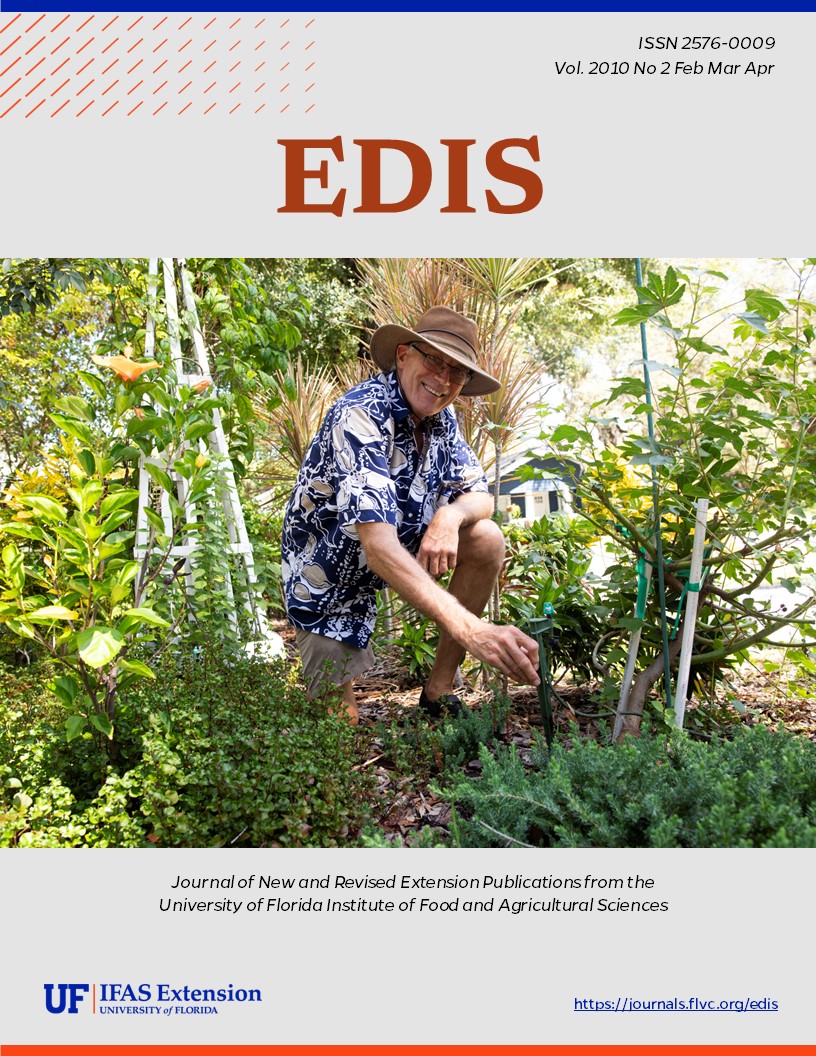Abstract
EENY-469, a 7-page illustrated fact sheet by Caitlin A. Lewis and Amanda C. Hodges, is part of the Featured Creatures collection. It describes this extremely polyphagous insect, native to Australia, that is considered to be a major pest of fruits and ornamental plants — distribution, description and life cycle, damage, economic importance, and management. Includes references. Published by the UF Department of Entomology and Nematology, January 2010.
References
Bailey P., Baker G., Caon G. 1996. Field efficacy and persistence of Bacillus thuringiensis var. kurstaki against Epiphyas postvittana (Walker) (Lepidoptera: CAPS PRA: Epiphyas postvittana 7 Tortricidae) in relation to larval behaviour on grapevine leaves. Australian Journal of Entomology 35: 297-302. https://doi.org/10.1111/j.1440-6055.1996.tb01407.x
CDFA. (2008). The Light Brown Apple Moth Program: 2008 Report to the Legislature. California Department of Food and Agriculture. http://www.cdfa.ca.gov/phpps/pdep/lbam/pdfs/Reports/2008LBAMLegRep.pdf (5 January 2010).
CDFA. (2009). Light Brown Apple Moth Eradication Program: (Draft) Programmatic Environmental Impact Report. California Department of Food and Agriculture. http://www.cdfa.ca.gov/phpps/pdep/lbam/envimpactrpt.html (5 January 2010).
Danthanarayana W. 1975. The Bionomics, distribution and host range of the light brown apple moth, Epiphyas Postvittana (Walk.) (Tortricidae). Australian Journal of Zoology 23: 419-437. https://doi.org/10.1071/ZO9750419
Espinosa A., Hodges A.C. (2009). Epiphyas postvittana. Bugwood Wiki. http://wiki.bugwood.org/Epiphyas_postvittana (5 January 2010).
Geier P., Briese D. 1981. The light-brown apple moth, Epiphyas postvittana (Walker): a native leafroller fostered by European settlement. pp. 131-155. In Kitching R, Jones R [eds.], The Ecology of Pests. CSIRO, Melbourne, Australia.
Irvin N. (2009). Light Brown Apple Moth. Center for Invasive Species Research. http://cisr.ucr.edu/light_brown_apple_moth.html (5 January 2010).
Jones D. (2009). Vigilance urged after moth find. San Jose Mercury News - Central Coast. http://www.mercurynews.com/centralcoast/ci_12661783?nclick_check=1 (20 September 2009).
Lay-Yee M., Whiting D.C., Rose K.J. 1997. Response of 'Royal Gala' and 'Granny Smith' apples to high-temperature controlled atmosphere treatments for control of Epiphyas postvittana and Nysius huttoni. Postharvest Biology and Technology 12: 127-136. https://doi.org/10.1016/S0925-5214(97)00050-1
Nair N.G. 1985. Fungi associated with bunch rot of grapes in the Hunter Valley. Australian Journal of Agricultural Research 36: 435-442. https://doi.org/10.1071/AR9850435
NAPIS. (2009). Reported Status of Light Brown Apple Moth, Epiphyas postvittana. Pest Tracker. http://pest.ceris.purdue.edu/searchmap.php?selectName=ITBUBPA (5 January 2010).
USDA-APHIS-PPQ. 1984. Pests not known to occur in the United States or of limited distribution No. 50: Light-brown apple moth. pp. 1-12. APHIS-PPQ, Hyattsville, MD.
USDA-APHIS-PPQ. (2008a). Light Brown Apple Moth. Animal and Plant Health Inspection Service. http://www.aphis.usda.gov/plant_health/plant_pest_info/lba_moth/background.shtml (5 January 2010).
USDA-APHIS-PPQ. (2008b). Questions and Answers: Light Brown Apple Moth. Animal and Plant Health Inspection Service. http://www.aphis.usda.gov/publications/plant_health/content/printable_version/faq_lbam.pdf (5 January 2010).
USDA-APHIS-PPQ. (2009). Economic Analysis: Risk to U.S. Apple, Grape, Orange and Pear Production from the Light Brown Apple Moth, Epiphyas postvittana (Walker). Animal and Plant Health Inspection Service. http://www.aphis.usda.gov/plant_health/plant_pest_info/lba_moth/downloads/lbameconomicanalysis.pdf (5 January 2010).
Venette R.C., Davis E.E., DaCosta M., Heisler H, Larson M. 2003. Mini Risk Assessment: Light brown apple moth, Epiphya postvittana (Walker) [Lepidoptera: Tortricidae]. Department of Entomology, University of Minnesota.

